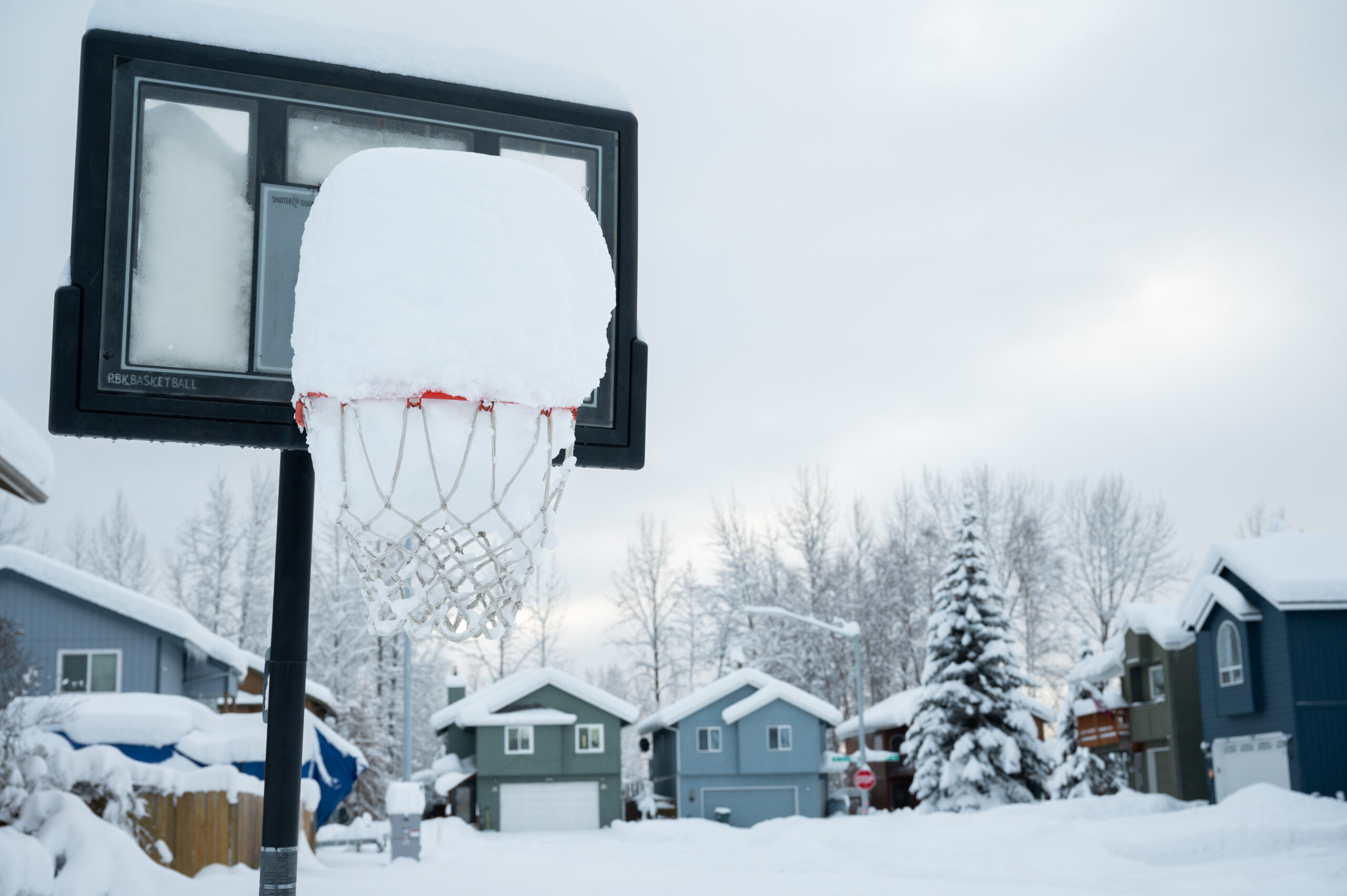
Update, 9:30 a.m. Monday: Anchorage received 0.2 inches of snow late Friday after this interview, bringing the 2023-2024 winter total to 132.6 inches and tying 1954-1955 as the second-snowiest winter on record, according to the National Weather Service.
Original story:
It’s been a snowy winter in Anchorage, so snowy, in fact, that 2023-2024 will go down as at least the city’s third snowiest winter on record.
A whopping 132.4 inches of snow — just a little over 11 feet — fell on Anchorage over the winter, as of the latest measurement Friday. That’s only 0.2 inches shy of the second snowiest winter of 1954 and ’55 and about two inches away from the all-time record of 134.5 inches set in 2011-2012.
But will the city see enough snow still this season to break either of those records?
Not likely, at least for the all-time record, say National Weather Service climate researcher Brian Brettschneider and meteorologist Carson Jones, in this special edition of Ask a Climatologist and His Forecaster Friend. But Jones isn’t ruling out a second-place finish just yet.
Listen:
[Sign up for Alaska Public Media’s daily newsletter to get our top stories delivered to your inbox.]
This interview has been lightly edited for length and clarity.
Carson Jones: So if we get another shower to that moves over our measuring location in West Anchorage, say tonight, then we might get into that second place category. We only need .2 inches. But otherwise, as you get further in April, we’re just getting a lot of daylight, the sun is getting stronger. Particularly if it snows during the daytime hours, it’s really hard to measure any accumulation. So it really has to happen overnight. But last year, we measured 1.7 inches in May. So there is that chance for something late season to happen that could could throw us over into the record territory.
Casey Grove: Yeah, I’m a little bit torn on this, because I was out at your guys’ office back in 2012 to see the measurement that broke the all-time record. So I’m kind of like, well, I got to see that, like, I’m not really interested in breaking the record as much. But how does that measurement actually work? It’s been, you know, 12 years since I saw that happen. I’ve killed a few brain cells since then. So like, what do you actually do? Is it a certain time of day? And how do you carry out that measurement?
CJ: Yeah, so with everything, it has to be standardized for the climate record (for) accuracy. So we measure at a minimum four times a day, so 4 a.m., 10 a.m., 4 p.m., 10 p.m. But in conditions like this, like we had today, really heavy shower goes over, you might get some accumulation really quickly, but it’s 35 degrees. So we go out, and we’ll measure that quickly, just so it’s not lost to melting, essentially.
CG: Gotcha. And then, are you you just use like a ruler? How do you do that?
CJ: We have a snow table in the yard behind our office. And that’s a white surface, so it tries to not really absorb any heat. So we measure it on that table, and then we clear it off on those six-hour increments.
CG: Well, so Brian, I wanted to ask you, is there any significance climatologically? Does that tell you anything that we had such a huge snow year this year?
Brian Brettschneider: Not really, because if you look at say, the last 15 years, you know, we had that record snow year in 2011-12. And this year, that’s near the record. We also had some pretty lousy snow winters, as well. So over the last 15 years, our average snowfall is only two inches more than the long-term average. And so it can be a little bit difficult to communicate that when you have a big snow year, and two in a row, that maybe this is the new normal. But (in) 2014-15, 2015-16 (Anchorage had) 20 inches, 25 inches for the entire season. That could happen again. Let’s hope not, but we shouldn’t expect big snow years to be the normal now.
CG: Correct me if I’m wrong, but the difference that you would expect to see with climate change, as the climate warms, is that the atmosphere can hold more moisture, right? But with snowfall, that’s more complicated than maybe more precipitation from more moisture, because you’re also warming things up. And of course, it needs to be cold enough to snow, right? So how does that all work again?
BB: So yes, but it is a little tricky, as you noted, with snow. So as you warm things up, the air can hold more moisture, and so as long as you’re still below freezing, you can squeeze out more snowfall. So what we’ve seen in most of the mainland (of Alaska ) is an increase in snowfall for the core winter months, you know, December, January, February, and a dramatic reduction in snow in the fall in the spring. And so that kind of, the net is, you know, we’re kind of hanging in there on snowfall, but we’re really squeezing that snow season in. And all you have to do is look at Juneau. You know, when you warm things up three or four or five degrees, you get a whole lot of winter rain. And so far in Southcentral, most of the mainland, we have avoided winter rain. We still get some but not like they do down in Southeast. But that’s probably our future in coming decades.
CG: What’s the snowpack like? I mean, the fact that there’s still snow out there from like November seems to indicate that we would have a pretty deep snowpack right now. Is that the case?
BB: Statewide we’re running at about 25% above normal for the snowpack. Here in Anchorage, we are at 22 inches for our snow depth. And that’s kind of notable, because we’re only two days away from, two or three days, from when we typically melt out our snowpack. So obviously, it’s going to be a little bit late this year. You know, if I had to guess, I would say probably about 10 days or so it’ll melt out, because it tends to go pretty fast once it starts going, and we’re supposed to get up to near upper 40s to maybe even near 50 degrees in seven or eight days. So it’ll it’ll start melting in a big hurry.
Casey Grove is host of Alaska News Nightly, a general assignment reporter and an editor at Alaska Public Media. Reach him at cgrove@alaskapublic.org. Read more about Casey here.





